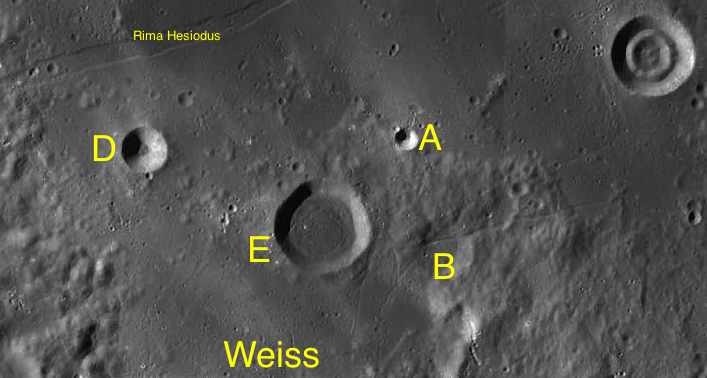Weiss (crater) on:
[Wikipedia]
[Google]
[Amazon]
Weiss is a
 By convention these features are identified on lunar maps by placing the letter on the side of the crater midpoint that is closest to Weiss.
By convention these features are identified on lunar maps by placing the letter on the side of the crater midpoint that is closest to Weiss.
lunar
Lunar most commonly means "of or relating to the Moon".
Lunar may also refer to:
Arts and entertainment
* ''Lunar'' (series), a series of video games
* "Lunar" (song), by David Guetta
* "Lunar", a song by Priestess from the 2009 album ''Prior t ...
impact crater
An impact crater is a circular depression in the surface of a solid astronomical object formed by the hypervelocity impact of a smaller object. In contrast to volcanic craters, which result from explosion or internal collapse, impact craters ...
along the southern edge of the Mare Nubium
Mare Nubium (Latin ''nūbium'', the "sea of clouds") is a lunar mare in the Nubium basin on the Moon's near side. The mare is located just to the southeast of Oceanus Procellarum.
Formation
The basin containing Mare Nubium is believed to ha ...
. It was named after Austrian astronomer Edmund Weiss
Edmund Weiss (26 August 1837 – 21 June 1917) was an Austrian astronomer. He was born in Frývaldov, Austrian Silesia, now Jeseník, Czech Silesia. His father, Josef Weiss (1795–1847), was a pioneer of hydrotherapy. His twin brother, Adolf Gu ...
. Nearly attached to the southwest rim is the crater Cichus, and Pitatus lies just over one crater diameter to the east-northeast. To the east-southeast lies the eroded Wurzelbauer.
The northern rim of this crater has been removed and the interior flooded by lava
Lava is molten or partially molten rock (magma) that has been expelled from the interior of a terrestrial planet (such as Earth) or a moon onto its surface. Lava may be erupted at a volcano or through a fracture in the crust, on land or un ...
, leaving a nearly featureless surface. The southern half of the rim still survives, although it is eroded in places. This rim climbs to a height of 0.8 km above the base. The satellite crater Weiss E lies at the northern edge of the interior floor, along the surviving remnant of the rim edge. A smaller crater just to the east of Weiss E has incised the low rise along the northeastern side.
The crater is marked by traces of the ray system
A ray system comprises radial streaks of fine '' ejecta'' thrown out during the formation of an impact crater, looking somewhat like many thin spokes coming from the hub of a wheel. The rays may extend for lengths up to several times the diameter ...
from the prominent crater Tycho, which lies several hundred kilometers to the southeast. To the north of Weiss is the rille
Rille (German for 'groove') is typically used to describe any of the long, narrow depressions in the surface of the Moon that resemble channels. The Latin term is ''rima'', plural ''rimae''. Typically, a rille can be several kilometers wid ...
designated Rima Hesiodus, named after the crater Hesiodus to the northeast.
Satellite craters
 By convention these features are identified on lunar maps by placing the letter on the side of the crater midpoint that is closest to Weiss.
By convention these features are identified on lunar maps by placing the letter on the side of the crater midpoint that is closest to Weiss.
References
* * * * * * * * * * * {{Commonscat Impact craters on the Moon